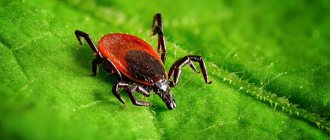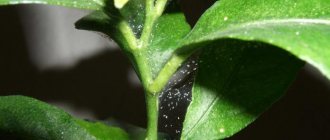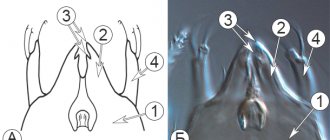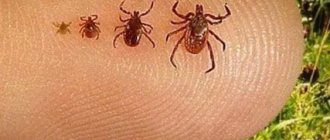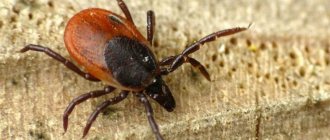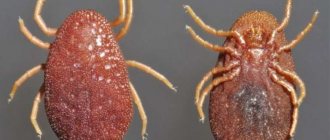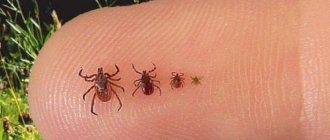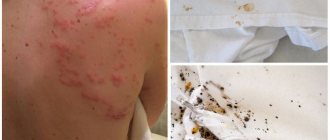The simplest surveys show that often ideas about the dangers of ticks and the tick-borne encephalitis they carry are quite vague, not only among school-age children, but also among adults. That is why newsletters and stands with the headings “Beware of Ticks!” are actively used in clinics, kindergartens and schools.
The following will provide key information about the dangers associated with tick bites, as well as rules of behavior in nature, the observance of which can significantly reduce the risk of attacks by these parasites and the likelihood of contracting various infections from them. Parts of this article can be used to make newsletters, memos, and stands. Based on it, classes can be conducted in preschool educational institutions, parent consultations and classroom hours in schools.
So, let's see what you need to know first about ticks and the dangers to humans associated with their bites...
Be careful: ticks!
Ixodid tick bites are one of the often underestimated dangers that a person may encounter when going out into nature, staying in rural areas, and even just while walking in green areas of cities in the spring and summer. When bitten by these arthropods, a person can become infected with deadly infections, and the treatment of the diseases they cause is complex and does not always end successfully.
Moreover, even with high numbers in the area, ticks are hardly noticeable, and they can wait both in the wild and in parks and courtyards within the city. Thanks to the anesthetic injected into the wound, their bites are painless, and often the parasite is detected only at the blood-sucking stage, when infected saliva has already entered the wound.
It is important to understand that, unlike stinging insects that attack humans in self-defense, ticks attack humans intentionally, since their survival and reproduction directly depend on blood sucking. Millions of years of evolution have provided the parasite with a very effective body structure and behavioral tactics, which together provide a high chance of finding a victim (host).
This means that to protect against tick bites you need not only to behave competently in nature (this is not enough!), but also to take special measures, which we will talk about a little later.
Food for thought...
As part of the project about the dangers of the spring-summer period, a consultation is required for moms and dads on this topic. I will tell you about the types of ticks, where they live, how best to dress for the forest and, most importantly, what to do if a tick does stick to a person’s skin.
When a bloodsucker is discovered, already clearly visible because it has already drunk blood, it is important not to panic or do anything stupid. You cannot rip it off, otherwise insect particles may remain in the skin, and if it is infected, then the person will become infected. If you remove the bastard correctly, then the likelihood of disease is minimal.
How to remove: it’s best to use a thread; you can always pull it out of your clothes somehow. We make a loop and put it on the tick, gradually pull it up and carefully pull it out. If you have tweezers, great, grab the “animal” with it and twist it around its axis and twist it out of the skin.
The most reasonable thing is to stock up on thread, tweezers and iodine for your walk in order to lubricate the bite site after removing the tick. By the way, there is a special device for removing insects, I don’t remember the name, but you can find it on the Internet. It looks like a fork; we place a tick between the teeth and twist it.
A rather controversial method of removal is using sunflower oil. Say, we pour it on the tick, it suffocates and releases its grip. But doctors are against this method.
The aerosol also helps protect against ticks; it is also available for sale. Better yet, if your area is “tick-dangerous” and you have to work in plantings and forests due to your occupation, or you are a tourism fan, then get vaccinated. You sometimes look at your local newspaper and know how often there are cases of tick infection in your region. So think about whether there is any point in vaccination or whether the usual precautions will do.
So, it seems like we were talking about ticks. Time to say good-bye! Subscribe, share, well, you know, right?
Sincerely, Tatyana Sukhikh! Till tomorrow!
By the way, I recommend reading:
Ticks and tick-borne encephalitis
Ticks are arthropods belonging to the class of arachnids. Today there are more than 54 thousand species in the world (and some experts believe that the real number of tick species, taking into account the forms that have not yet been described, may be many times greater).
Different types of ticks differ significantly in their lifestyle, feeding methods and habitats. Most of them are completely harmless to humans, and some are even beneficial for agriculture.
The greatest danger to humans is posed by the so-called ixodid ticks - a relatively small group of species that are highly specialized parasites of large animals and humans. They feed on blood, and for saturation, growth, development and reproduction they must consume the blood of host animals. For this reason, the lifestyle, body structure and habits of ticks are maximally adapted to lying in wait for animals, attacking and sucking the maximum amount of blood possible for these arthropods.
The blood sucking of ticks in itself, although unpleasant for humans, does not pose a significant danger. In only a small number of people, stings can cause severe allergic reactions. Those types of ticks whose bites are extremely painful and allergenic are rare in Russia.
The greatest danger comes from infections whose pathogens develop in ticks and can be transmitted to humans through a bite. Of these infections, the two most significant are:
- Tick-borne encephalitis;
- Lyme borreliosis (Lyme disease).
Both of them can lead to death or disability of an infected and sick person if he is not promptly provided with medical assistance.
In addition to these diseases, ixodid ticks also carry anaplasmosis, Marseilles fever, tularemia and some other diseases.
The most dangerous tick-borne disease is tick-borne encephalitis. This disease is quite difficult to treat, and due to brain damage, irreversible neurological and mental disorders are possible, and in the most severe cases, death of the sick person.
Not every ixodid tick is a carrier of the causative agents of these diseases, and not even every bite of a truly infected tick leads to the development of the disease. According to statistics, even in the most epidemiologically dangerous regions, only 6% of ticks belonging to the species that transmit encephalitis and borreliosis are infected with these infections. And out of 100 people bitten by infected parasites, only 5-6 develop encephalitis or borreliosis.
On a note
These numbers seem small: in fact, out of 10,000 tick bites, only 20-25 lead to infection. However, in reality, even with such a low infectivity, ticks are dangerous due to their large numbers. At the end of spring - beginning of summer, the grass layer of 1 hectare of sparse deciduous forest can contain several million ticks of different ages, and during an ordinary hour-long walk, several dozen parasites can get on a person’s clothes or body. People who, for one reason or another, are constantly in nature (agricultural and forestry workers, landscapers, fish farm workers, gardeners) are bitten by ticks regularly, and even city residents are bitten during relatively rare trips into nature.
The greater the number of ticks that simultaneously begin sucking blood on a person, the higher the likelihood of infection. According to statistics, the most severe cases of tick-borne encephalitis were recorded among hunters and fishermen, from whose bodies, after going out into nature, several dozen attached parasites were removed.
In Russia, Ukraine and Belarus, the main vector species of tick-borne encephalitis are:
- Dog tick (Ixodes ricinus), common in the European part of Russia, Ukraine and Western Europe;
- Taiga tick (Ixodes persulcatus), living in Siberia and the Far East.
Carriage of the virus has also been recorded in some other species of ixodid ticks, but their epidemiological significance is much lower.
Dog and taiga ticks are very similar in appearance, and only a specialist can identify the differences between them.
For example, the photo below shows a dog tick:
And here is the taiga tick:
Moreover, in natural conditions it is difficult for a non-specialist to distinguish the types of ticks that carry encephalitis from the species that do not carry the virus. Therefore, it is generally accepted that any forest tick can potentially infect a person through a bite, and ixodid ticks themselves are often called encephalitic in everyday life, which is not entirely correct.
Who provides instruction for children?
In preschool educational institutions (PEIs), educators and medical workers talk about the dangers of ticks, rules of conduct in the forest, and in nature. Since children are still small and will not understand the full danger of tick-borne encephalitis, it is advisable to hold a conversation on the topic “Beware of ticks!” with parents.
On a note!
The pedagogical portal provides for the implementation of explanatory work among schoolchildren of younger and older age. Class teachers and a medical worker conduct classes for students. Staff from a local clinic may be called upon to provide outreach.
Parents should also tell children about ticks in a way that is accessible to them. The advantage of such a conversation is that the child is not afraid to ask questions, to ask what is not clear.
Where do ticks live and how do they bite?
In summer and spring, adult ixodid ticks stay on the grass, lower branches of bushes, on the ground, waiting for a person or any large animal to appear next to them. When the parasite senses an approaching victim, it extends its front pair of legs forward and above itself, and if a person touches the blade of grass on which the parasite is located with his clothing or body, the parasite immediately clings to the clothing or skin with its paws and presses against it. Then the parasite crawls to the most suitable area of the body, bites through the skin, reaches a blood vessel with its chelicerae, pierces it and begins to suck blood.
On a note
Ticks can also move to humans from domestic animals (for example, when milking cows) and attack from the branches of low bushes, but this rarely happens.
The structure of the body and oral organs of the tick is such that after the start of blood sucking, the parasite is very securely attached to the skin, into which its head is almost completely immersed. It is very difficult to remove it from the body - in many cases, if it is removed incorrectly, the body of the parasite is torn off from the head. If the head is not removed from the skin after this, an abscess and suppuration may develop in this place.
It is also useful to read: How are tick bites dangerous for humans?
The tick sucks blood for a long time - from several hours, if it is a small immature individual (nymph), to 3-4 days, if it is an adult individual (imago). Females feed especially for a long time, as they need a large amount of food for the development of eggs. The digestive system and body of the tick are adapted to receiving large amounts of blood, and therefore, during feeding, the size of the arthropod can increase several times, and the weight - hundreds of times.
If the parasite has successfully sucked blood, it detaches from the host and falls to the ground. Adult females then look for a secluded place under stones, in cracks in the ground, under leaf litter, where they lay from several hundred to several thousand eggs and die.
The eggs hatch into larvae that attack mainly rodents and insectivorous mammals, and after saturation they molt into nymphs. Nymphs feed on hares, dogs, cats, hedgehogs, and less often on ungulates and humans, then molt and turn into adults. At this stage, males, after satiation, often mate with females directly on the host's body, and fertilized females repeat the reproductive cycle.
The photo shows a mouse with several ticks embedded in its skin:
It is adult ticks that most often attack humans. However, any individual at any stage of development can be infected with the tick-borne encephalitis virus.
To move to a new stage of the life cycle, as well as for reproduction, each individual must drink blood once.
The largest numbers of ticks inhabit meadows, vast forest clearings, river valleys, and pastures, including mountain ones. However, they are very numerous in parks (including within large cities), in summer cottages and gardens, and in forest belts. The higher the grass in a particular place and the less often the soil is plowed there, the more favorable the conditions for the life of ticks.
In Russia, Ukraine, Kazakhstan and Belarus, the peak of tick activity and the largest number of tick bites are recorded in May, June and July. In the southern regions, bites can be observed as early as the end of March, and in the northern regions they are registered until August.
Materials for the parent's corner in the preschool educational institution - information in the parent's corner
Materials for the parent's corner in a preschool educational institution - information in the parent's corner
And now, let's figure out what information can be placed in the parent's corner. Remember that it should be presented as positively, clearly and, if possible, in not very large volumes. It is unlikely that parents will stand near the stand for a long period of time; they should see a short and informative message in front of them. It is also important to take into account that when placing printed information on a stand, it is necessary to indicate the authorship, date of publication of the material, and, if available, a link to the website, so that you can familiarize yourself with the material in full.
Materials for the parent corner in the preschool educational institution - information in the parent corner:
- Materials about the physical development of children
- Materials about the mental development of children
- Materials about aesthetic education
- Materials about developmental features
- Materials about health, ways to improve your health
- Materials about self-care skills
- Materials about planned classes
- Materials about children's literature
- Materials about music and musical works
- Materials about teaching methods for preschoolers
- Materials about the seasons
- Materials on speech development
- Advice from psychologists, speech therapists, pediatricians
- Thematic materials - New Year, March 8, Easter, February 23
Where and when can you become infected with tick-borne encephalitis?
You can become infected with tick-borne encephalitis during the active season of ticks in any epidemically dangerous region where these parasites live. A bite with transmission of infection can occur:
- In the park, in vacant lots between houses;
- In the garden, in the garden, on the plot;
- In the forest or on the river bank;
- In a meadow, pasture during a hike or picnic;
- In a mountain valley (for example, in Altai or Sayan Mountains).
The main conditions for the existence and activity of ticks are the presence of grass, in which they hide and from which they attack people, as well as various shelters on the ground - leaves, pieces of wood, stones, just cracks. The higher the grass in a particular place and the more shelters on the ground, the more ticks there are, as a rule, and the higher the likelihood of their attacks.
Also, the likelihood of bites is higher in wild areas where there are a large number of different tick hosts (rodents, insectivores and ungulates).
The tick-borne encephalitis virus does not pose a threat to the tick and does not kill it. Therefore, being infected at any stage of its life cycle, a tick can pose a danger to humans for the rest of its life.
The peak incidence of tick-borne encephalitis and Lyme disease coincides with the peaks of tick activity in nature. The greatest number of infections is recorded from May to July, and in warm and hot weather the parasites are most active and the most bites occur.
Memo for parents
Tick-borne encephalitis can be contracted not only by a tick bite, but also by drinking fresh milk. Goats suffer from encephalitis, contracting it from ticks, and viral particles spread throughout their body and enter the milk. Consuming such milk without heat treatment can cause infection. Cows, unlike goats, do not suffer from encephalitis, but the virus can also penetrate into their milk from biting ticks.
Decorating a parent's corner in a kindergarten locker room - educational material
Decorating a parent's corner in the kindergarten locker room:
Decorating a parent's corner in the kindergarten locker room
Decorating a parent's corner in the kindergarten locker room
Decorating a parent's corner in the kindergarten locker room
Decorating a parent's corner in the kindergarten locker room
Decorating a parent's corner in the kindergarten locker room
Decorating a parent's corner in the kindergarten locker room
Decorating a parent's corner in the kindergarten locker room
Decorating a parent's corner in the kindergarten locker room
Decorating a parent's corner in the kindergarten locker room
Decorating a parent's corner in the kindergarten locker room
Geography of tick-borne encephalitis: the most dangerous regions
Tick-borne encephalitis has been reported in central Eurasia and in some states of Australia.
The area of distribution of the disease in Eurasia runs in a narrow strip from the North Sea in the west to the Sea of Okhotsk in the east. Its foci and individual cases of infection are known in the Netherlands, Finland, Germany, Ireland, Poland, the Czech Republic, Latvia, Lithuania, Estonia, and Yugoslavia. The disease is widespread throughout Ukraine and Belarus, but in Ukraine more or less constant outbreaks are recorded only in Transcarpathia.
In Russia, the disease is recorded throughout the European part south of Karelia, in the Urals and in Southern Siberia. The spread of tick-borne encephalitis stretches across the entire country and reaches the Far East, covering the northern regions of Kazakhstan, Mongolia and China. Isolated cases of infection have been reported in Kyrgyzstan.
Among the regions of Russia, the most severe epidemiological situation is observed in the Sverdlovsk, Tomsk, Irkutsk and Omsk regions, the republics of Khakassia, Tuva and Buryatia, and the Krasnoyarsk Territory. The largest number of cases of bites and infections transmitted by ixodid ticks is recorded here. At the same time, in the Far East there is a maximum mortality rate of the disease with an overall lower incidence of infection.
What to do after a tick bite?
In most cases, tick bites are noticed at the stage when the parasite has already attached itself to the skin. The tick sucks blood for a very long time, and therefore it is difficult not to notice it on the body (although this also happens - on various hikes and expeditions, when people do not undress or bathe for a long time). If the body is examined at least once a day, all sucking bloodsuckers can be detected.
If a tick is found on the skin, it should be removed as quickly as possible. If it has not yet stuck, then you can simply shake it off, and if it has already stuck, then you need to remove it from the skin. This can be done in several ways:
- Remove using a special extractor - a tool in the form of a spatula with a groove, which grabs the tick at the point of its contact with the skin and removes it with a gentle movement;
- Remove with thread. A tightening loop is made in the middle, it is thrown over the parasite and tightened at the point of contact with the skin. Then, with gentle sideways movements, the tick’s body loosens in the wound and gradually stretches out;
- Remove with your fingers. In this case, the tick is grabbed by the body and rotates in the wound. At the same time, its proboscis ceases to be retained in the tissues and the parasite is easily removed.
It is also useful to read: How to distinguish an encephalitis tick from a regular (non-contagious) parasite
After removing the tick, the wound must be treated with any antiseptic: an alcohol solution of iodine, hydrogen peroxide, medical alcohol.
If for one reason or another the head of the parasite remains in the wound, you should try to remove it, just as you remove a splinter. If this was not possible, then it is advisable to see a doctor who can remove the remains from the skin and properly treat the wound.
It is advisable to save the removed tick and submit it for examination to the laboratory within 24 hours. The analysis will make it possible to accurately determine whether the tick was infected with the tick-borne encephalitis virus or Borrelia.
On a note
Laboratories in which relevant research is carried out operate at sanitary and epidemiological stations, hospitals and clinics in all major cities. The address of the nearest point where you can submit a tick for analysis can be found by calling the Rospotrebnadzor office in a specific area.
If tests show that the parasite is infected with the tick-borne encephalitis virus, the affected person must be taken to a medical facility. Here he will undergo emergency prophylaxis, which consists of introducing an immunoglobulin drug into the body. This remedy blocks the further development of infection and prevents disease.
Important!
Specific prevention measures are effective only during the first 4 days after the bite, but in the best case, the victim needs to be administered immunoglobulin in the first two days.
If it is not possible to take the bitten person to a hospital or clinic, you must remember exactly (or better yet, write down) the date of the bite. In the future, when the first signs of illness appear, the victim should be taken to a medical facility as quickly as possible, and the doctor should be informed of the date of the bite. This will help you take the most effective treatment measures.
Emergency prevention of Lyme borreliosis is not required, since this disease is relatively easy to treat and can be quickly treated when the first symptoms appear.
Advice on existing precautions
The arthropods themselves are not dangerous, but in the process of biting they transmit dangerous diseases. Therefore, prevention should be aimed primarily at preventing suction.
A reminder for parents “Beware of ticks” consists of following the following rules:
Dress for a walk in the forest
- If you and your child go out into the forest, park, summer cottage, etc., you need to cover your feet. To minimize access to parasites, it is recommended to tuck pants into shoes or under the elastic of socks. T-shirts and tank tops are tucked into trousers. Sweatshirts with sleeves ending in cuffs are desirable so that they fit close to the skin. The collar must be fastened tightly. The majority of parasites come from grass, but there are species that live on trees. Therefore, a scarf or a light hat under which you can tuck your hair will not hurt.
- A light, solid color of clothing is preferred. This will make it easier to detect the pest.
Aerosol against ticks
- When relaxing in the forest, try to avoid standing in tall grass and shady places. It is better to spend the night outdoors in places devoid of vegetation. Dry pine areas and sandy soils are less dangerous.
- Conduct inspections every 15 minutes. This way you can prevent suction.
- There are so-called acaricidal substances. They are produced in the form of aerosols and are intended for treating clothing. These chemicals cannot be used on the skin, but they have an odor that repels arthropods. Another type of aerosol is repellent. They are approved for use on the skin and are designed to protect against mosquitoes and ticks. The products are sold in pharmacies and when planning a long vacation in nature, you can use them.
- Pets should be examined after every walk to remove any attached parasites. In exactly the same way, after going outside, we inspect our clothes and each other.
- Try not to bring outerwear or picked plants into the house, where unwanted guests may end up.
- Encephalitis is a very dangerous disease and the best prevention is vaccination.
- Parents should know how to remove the parasite if it is attached.
Signs of infection with tick-borne encephalitis and other tick-borne infections
After a tick bite, it is necessary to carefully monitor the condition of the bitten person for at least a month, and if signs of tick-borne infections appear, promptly take him to the hospital.
The incubation period for tick-borne encephalitis and Lyme borreliosis lasts 7-14 days, but for Lyme disease it can in some cases be significantly longer - up to a year or more.
The main symptoms of tick-borne encephalitis:
- Typical fever with increased body temperature, malaise, nausea, pain in the head and muscles;
- Impaired coordination of movements;
- Fainting, dizziness;
- Neck stiffness.
Similar symptoms develop with Lyme disease, but its most clear sign is the so-called erythema migrans: a large red spot at the site of the bite, surrounded by a clearly separated ring. At the site of erythema, many patients experience pain, itching or burning.
Also, with Lyme disease, allergic reactions are pronounced: skin rash, flu-like syndrome.
Any of these signs most likely indicates the onset of the disease. The sooner treatment is started, the higher the likelihood of a successful outcome.
Treatment in case of infection
Treatment of tick-borne encephalitis is very difficult due to the lack of drugs that can quickly eliminate the viral infection in the body. In medical practice, immunoglobulin preparations are used, but at the stage of acute manifestation of symptoms, these drugs are no longer effective.
High dosages of interferons used for intravenous infusions can have a positive effect, but do not guarantee the destruction of the pathogen, but only provide some protection for cells that have not yet been affected. For this reason, even in a clinical setting, the likelihood of curing the disease is not absolute.
Important!
The later and the more severe the condition the patient is brought to the clinic, the higher the likelihood of developing irreversible mental disorders and death.
Treatment of tick-borne encephalitis involves strict bed rest with limited physical activity, parallel symptomatic therapy to normalize the patient’s condition, and taking antihistamines if allergies occur.
Lyme disease can also be treated in a hospital setting, but with the use of antibiotics. Its causative agent is sensitive to tetracyclines, penicillins, and cephalosporins, so the doctor’s choice is quite wide. If there is a risk of complications in the joints, heart or nervous system, long courses of bicillin are administered.
Lyme disease can become chronic if treatment is ineffective. In this case, the disease is often complicated by arthritis, osteoporosis and other joint lesions.
Parents' Corner - kindergarten preparatory group
The preparatory group of the kindergarten is attended by future first-graders, and therefore the parent corner should have as much information as possible related to preparing for school. Below you will find ideas for filling such a stand.
Parents' Corner - kindergarten preparatory group:
Parents' Corner - kindergarten preparatory group
Parents' Corner - kindergarten preparatory group
Parents' Corner - kindergarten preparatory group
Parents' Corner - kindergarten preparatory group
Parents' Corner - kindergarten preparatory group
Parents' Corner - kindergarten preparatory group
Parents' Corner - kindergarten preparatory group
Parents' Corner - kindergarten preparatory group
Parents' Corner - kindergarten preparatory group
Parents' Corner - kindergarten preparatory group
Ways to prevent tick bites and tick-borne encephalitis infection
Competent behavior in nature and following simple rules can reliably protect against tick bites.
In particular, in the second half of spring and the first half of summer, after being in nature, especially in places with unmown grass, you need to conduct a mutual inspection of the body. Adults examine the children and then each other, paying special attention to the legs, back, buttocks, groin, armpits, scalp, and behind the ears. When detected, ticks are shaken off or removed from the skin.
It is advisable to carry out such inspections every 1-2 hours. In this case, ticks can be detected immediately after they hit the body, even before suction.
In places where there are signs “Attention, ticks!”, or similar ones, it is better not to walk unnecessarily, and after a walk you must inspect the body.
In regions with a high risk of infection with tick-borne encephalitis, additional measures are required:
- You need to go out into nature in special clothes. Pants should be tucked into socks or have elastic bands that fit snugly around the leg. Underwear, a shirt or jacket should be tucked into pants, and there should also be elastic bands on the sleeves that ticks cannot crawl under. If you plan to stay in a forest with a lot of bushes, it is advisable that your sweater or jacket have a hood. All these measures will reduce the likelihood of ticks penetrating the skin;
- Clothing for going out into nature should be light-colored so that the parasite on it can be easily detected;
- Clothing or body should be treated with repellents, preferably DEET-based - they are reliable protection against ticks and other blood-sucking parasites.
Directly in nature, you should stay away from tall grass and bushes.
In the most epidemiologically dangerous regions, it is advisable to get an anti-encephalitis vaccination, which will provide reliable protection against the disease even if a bite has taken place.
Prevention measures also include informing the population about the rules of behavior in nature and preventing tick bites. For this purpose it is useful:
- Conduct classes and discussions in schools on the topic of proper behavior of schoolchildren in nature;
- Conduct consultations with parents in preschool educational institutions and schools about precautions to protect against tick-borne encephalitis;
- To produce noticeable and eye-catching health bulletins, stands, posters, leaflets, booklets, folders with drawings and photographs, which are hung or distributed in clinics, hospitals, schools and kindergartens, in the entrances of houses;
- Conduct briefings for educators in kindergartens and teachers in schools, vacationers in various sanatoriums, prepare orders in advance for conducting such briefings;
- At the beginning of the tick season or before it, publish advisory articles in newspapers and reports on local television channels with warnings about the danger of bites and recommendations on how to avoid them;
- Make notifications in schools about the need to vaccinate students and their parents in epidemiologically dangerous regions;
- Involve students in educational work - develop information stands and make warning signs, conduct thematic biology lessons with demonstrations of live ticks.
The picture below shows a version of an information stand on the topic of tick-borne encephalitis:
The main responsibility for observing the rules of protection against tick bites and the prevention of tick-borne infections in children lies with the parents. Measures to protect yourself from infection are not officially mandatory even in the most dangerous regions. But how diligently and to what extent both adults and children observe these measures depends on their safety in nature and the likelihood of a successful outcome if they are bitten by a parasite.
Be careful in nature, beware of ticks and help protect your loved ones from them!
Useful video about the danger of ticks to humans
Memo for parents “Attention, ticks!”
Memo-instructions
for parents of students
attending
a summer health camp at school
Dear parents!
The administration and teaching staff of the school express their confidence in your interest in the need for organized recreation, recreational work, educational activities, socially useful work, and leisure activities with children during the summer holidays.
Meeting your wishes and taking into account its and your capabilities, the school is actively involved in organizing and providing feasible support for the summer health campaign.
In this regard, the school reminds you of some circumstances that ensure the most optimal implementation of the tasks of the summer health period through the activities of summer health camps.
1
When accompanying your child to camp, you should set him up for a positive perception of the opportunity to be among his peers.
2
.It is necessary to provide the child with clothing appropriate to the weather conditions every day.
Z
.You must have information about your child's employment schedule
in the association he resides. 4
.If it is impossible for your child to attend the camp, you must
inform the head of the association about this in advance. If similar
This fact has already happened - it is important to notify the manager without delay
association about its cause and agree on further actions on the issue
visiting the camp.
If a child fails to attend the camp without prior notification (oral or written), the child retains his right to be provided with food for the period until the circumstances are clarified, but the return of parental funds contributed to the organization of meals becomes impossible, because sums of money are transferred to the account of the supplying organization and spent according to the application for food.
A refund of parental funds is also not possible if the child does not attend the camp upon prior notification, but in this case the child is removed from meals for a specified period and the funds allocated for the organization of meals from the social insurance fund and the local budget are retained.
5
.The child must be provided with towels for hands and face for hardening procedures. Towels must also be changed at least once a week.
6
.If a child visits a work site, whenever possible
and needs it is necessary to provide the child with a comfortable environment for work
clothes, hats, mittens.
7
.Every day it is necessary to monitor the child’s well-being and take an interest in
his physical and mental condition.
Administration and
school teaching staff.
How dangerous are ticks?
The bite itself is not that bad. It can cause redness, itching, and slight swelling in the wound area. Much more dangerous are the infections that enter the human bloodstream when a tick bites with its saliva, as well as when it is crushed. This is primarily tick-borne encephalitis
. It is caused by viruses that attack the central nervous system. The first symptoms after a bite appear within two weeks. The disease develops acutely, over several days. Threatens complications in the form of paralysis. Unfortunately, this disease has a high mortality rate.
Methods of protection against ticks are divided into specific and nonspecific. Specific ones are vaccinations. Vaccinations begin in the cold season, in autumn or winter. The course consists of two vaccinations with an interval of 1-3 months. Rapid vaccination is provided at intervals of 14 days. Repeated vaccinations against tick-borne encephalitis are carried out after 9-12 months and 3 years.
Ticks spread borreliosis or Lyme disease even more actively. People do not die from this disease, but it causes dangerous complications on the heart and joints. The insidiousness of borreliosis is that its symptoms resemble a common cold - cough, runny nose, headache, weakness. And most victims do not see a doctor. Lyme disease manifests itself as intense redness at the bite site. It looks like a spot with bright edges. Unfortunately, there is no vaccine against this disease yet. The incubation period for borreliosis is about one month. However, after 1-2 weeks, protective antibodies appear in the blood during the disease - immunoglobulins specific for borreliosis. They are found in the blood. There are situations when it is necessary to know whether a baby was infected by a tick bite, whether he can get sick or not, then it is recommended to do a blood test to detect specific immunoglobulins.
How to protect yourself from a tick bite?
Theater begins with a hanger, and protection against ticks begins with clothes. Tuck your pants into your socks. Do not leave your neck and head exposed: a turtleneck, a light scarf, etc. There are many cases when a tick, crawling along the back, ends up in an open gate. If your child is running around on the grass naked, check him every 20 minutes. The tick never digs in right away; it crawls upward for a long time. It is much easier to see a tick on a naked person, especially a small child.
The tick needs to crawl 10 cm across the poisoned tissue for the product to take effect. And what kind of fabric are you planning to poison? - that's right, natural. The active ingredient in some repellents destroys synthetic materials. When going to a park or forest area, dress your child in light-colored clothes! On dark clothes you will look for a tick much longer.
What to do if you find a tick attached to your child?
You do not need to try to remove the tick immediately; you can squeeze its contents into the wound along with the infection (if the tick is contagious). The head remaining in the skin will cause suppuration. Grab the tick with a thread or tweezers as close to the skin as possible and very carefully, very carefully, unscrew it. We hold the tick strictly perpendicular to the skin. After the procedure, be sure to wash your hands. There is no need to drip oil, gasoline or alcohol onto the tick - this is dangerous! Pharmacies sell special hook loops, which come with instructions. If a tick has stuck to a hard-to-reach place, or you are not sure that you can pull it out on your own, it is better to contact a specialist. If the proboscis remains in the skin, you should consult a doctor to have it surgically removed. Treat the suction site with tetracycline or chloramphenicol ointment, alcohol or iodine and cover with a bactericidal bandage. Place the removed tick in a glass jar and place a paper napkin moistened with water in it. The tick must be delivered to the laboratory no later than two days later.
First aid for a child with insect bites
In the summer, we and our kids face such troubles as insect bites. How to protect children from the negative consequences of bites? How to avoid allergic reactions?
Symptoms
Insect bites - mosquitoes, bees, wasps, hornets, horseflies, fleas, ticks and spiders - are especially common among children who are often outdoors. Usually the bite causes a red spot with a small wound, sometimes bleeding, as well as a small swelling.
CAREFULLY:
You should inform your doctor as soon as possible if:
significant swelling has developed around the bite site;
- high fever, headaches, drowsiness or other symptoms persist for a week after the bite;
- pus appeared at the bite sites;
- swollen lymph nodes are observed on the neck or other parts of the body;
- lice were found in the hair;
- flea bites were found;
- Solenopsis tick bites were found.
URGENTLY!
Tell the doctor right away if your child shows signs of loss of consciousness or is so weak that he or she cannot move. If there is no doctor, don't wait. Take your child to the hospital immediately.
All of these symptoms may be signs that the child is in shock, which occurs in some people who are hypersensitive to stings (especially bees). Call your doctor immediately if you have any other symptoms—itching around the head, hives, cough, redness of the skin, nausea, vomiting, or difficulty breathing.
Parents' actions
In most cases, all that is required is washing the bite with soap and water, applying ice or a cold compress, and finally covering the bite with a clean bandage.
When it comes to flea bites,
then you should examine your pets and destroy their insects. In any case, the incident must be reported to the doctor.
bites should be treated very carefully .
If a doctor is not nearby, you can remove many ticks yourself by carefully pulling them out of the skin with tweezers. Then you should inspect the bite site to make sure that the head of the tick is not left in the skin. If it is still there, it should also be removed. Grab the head with tweezers and pull it straight. If necessary, first use a sterile needle to release the head from the skin. You need to act carefully so as not to crush the tick.
If symptoms other than a direct bite are present, you should inform your doctor. If your child loses consciousness or his reaction to the bite seems serious, take him to the doctor right away.
To what has been said, we must add: our doctors recommend that after removing the sting containing poison, limit yourself to wiping the bite site with a solution of alcohol or iodine. Cold is applied to reduce pain and swelling. You should not put earth on the site of a bee or wasp sting, as some traditional healers advise. The soil can carry the pathogen of purulent infection and tetanus.
Heat stroke or overheating in the sun in a child
With the arrival of summer, the heat takes over... In general, in relation to the sun and heat, people are divided into 3 categories:
easily tolerant of heat
indifferent to heat
hard to tolerate heat
But both categories can experience such phenomena as heat or sunstroke.
Definition of Heat Stroke
Heatstroke is a condition of the body that occurs as a result of overheating. As a result, the mechanism of heat transfer and thermoregulation is disrupted. Namely, the body, due to the low fluid content in it, stops secreting sweat, as a result of which cooling does not occur, the body overheats, and the body temperature rises. This is one of the most dangerous human conditions, which can lead to death if timely first aid is not provided. It is very important to promptly recognize the onset of heat stroke, and for this you need to know its signs.
Symptoms of overheating in the sun (heatstroke)
- redness of the face
- dizziness
- very severe, unbearable headache
- nausea (sometimes even vomiting)
- darkening of the eyes
- no sweat
- convulsions (due to dehydration)
- loss of consciousness
First aid for heat or sunstroke in children
Move the victim to a cool place and undress. If possible, place it in cool (but not cold!) water, reaching up to the navel, and rub the whole body.
Apply ice to the armpits and head.
Wipe your entire body with alcohol.
Give the victim a cool drink. It is better to eat this in cool water, with the addition of valerian tincture at a rate of 20 drops per third of a glass of water.
If you have trouble breathing, bring cotton wool soaked in ammonia to your nose.
General tips for preventing overheating in the sun
Heat stroke can happen very easily, and you need to know when it might catch you by surprise. Therefore, there is no need to walk in the heat without a hat, play sports in a poorly ventilated room, drink small amounts of liquid, drink alcoholic beverages and coffee before going outside. If you feel that your strength is leaving you, then immediately quit everything and go to rest until you feel better. Do not wear thick and heavy clothes; try to wear clothes made of “breathable material” in light colors. Drink more fluids. Cool, unsweetened tea quenches your thirst especially well. If you feel unwell along the way, lean against something cold - this will help your thermoregulation. And remember the most important thing - you don’t have to wait until you feel bad. After all, it is easier to prevent than to cure!
REMINDER FOR PARENTS “ Attention! Mushrooms !"
Dear parents! Cases of mushroom poisoning have become more frequent. Remember! When collecting mushrooms, pay attention to their appearance and suitability for eating! When walking with children, make sure there are no mushrooms in the grass. A child may put an inedible mushroom in his mouth and swallow it. It must be remembered that the effect of poison on the body is very dangerous and can lead to death.
Signs of mushroom poisoning
: drooling, profuse sweating, vomiting and loose stools mixed with blood. With a large dose of poison, blurred vision, convulsions, delirium, and respiratory distress are observed.
If poisoning occurs, it is necessary to provide first aid aimed at removing the poison from the body: 1. Gastric lavage.
2. Ingestion of activated carbon.
3. Transport to the nearest medical facility in the lateral position.
REMINDER FOR PARENTS
PROTECTING THE LIFE OF CHILDREN AT WATER OBJECTS
1. Do not leave children unattended near bodies of water - it is dangerous!
2. Never swim in unfamiliar places!
3. Do not swim in polluted waters!
4. Do not swim in bodies of water that have holes and springs!
5. Do not allow children or arrange noisy games on the water while swimming - this is dangerous!
6. If, while relaxing or swimming, you see that a person is drowning or needs your help, help him using a lifebuoy!
7. When in the sun, take precautions against overheating and heatstroke!
RULES FOR CROSSING THE STREET
When teaching your child to cross the street competently, explain to him that it is necessary to strictly, step by step follow the following rules.
Find a safe place.
There is not always a pedestrian crossing nearby. The main thing is that the crossing point has a good overview: there are no turns, hundreds of cars or other obstacles for inspection nearby.
Stop on the sidewalk near the curb.
You should always stop and pause to observe and evaluate the situation; Never go out, much less run out onto the road.
Listen and look around.
Listening means throwing extraneous thoughts out of your head. Remember that dangerous vehicles may be hidden. Look around, turn your head left and right.
If you see approaching traffic, let it pass.
Always give way to a moving vehicle.
If there is no transport, cross the road at a right angle.
Continue to look and listen carefully until you cross the road.
You need to look both ways when crossing repeatedly, because the situation on the road may change: a car will suddenly appear, or a vehicle driving straight will suddenly turn.
Behavior during a thunderstorm.
During lightning strikes, do not come close to electrical wiring, lightning rods, roof gutters, antennas, do not stand near a window, and if possible, turn off the TV, radio and other electrical appliances. During a thunderstorm, water and the banks of reservoirs are dangerous. If you are swimming, immediately return to the shore; if you are sailing in a boat, reel in your fishing rods: “heavenly electricity” does not hit the water, but objects rising above its surface. Do not be in a body of water or on its shore. Move away from the shore, go down from a high place to a low place. During a thunderstorm, it is recommended to stay as far away from the water as possible. A lightning strike into water affects everything within a 100 meter radius.
Forbidden:
- take cover near lonely trees; - lean against rocks and steep walls; - stop at the edge of the forest; - stop near bodies of water; - hide under a rocky overhang; - run and fuss; - move in a tight group; - wear wet clothes; - be near the fire; — store metal objects in the tent; - use electrical appliances in the house.
If during a thunderstorm you see orange reflections on the walls of your room, and it seems to you that there is a fire outside the window, immediately slam the window (if it’s not too late): ball lightning is asking to visit you.
Ball lightning
is a ball with a diameter of 10 to 35 centimeters (although there are also kilometer-long specimens, but these are unlikely to fit into your window).
It often has a yellow color (other colors are not excluded), its temperature is from 100 to 1000 degrees, and its weight is 5-7 grams (even for a kilometer-sized one). Ball lightning loves to penetrate houses. Objects and obstacles on the way do not stop it; scientists do not yet know whether glass is a reliable protection against it. It can penetrate various cracks (sockets, intercoms, etc.), but most likely it will not fly out of them.
Behavioral tactics when encountering ball lightning
Do not grab iron objects, do not try to run away from her, do not try to drive her out with a broom, book, etc. Stand still, remain calm. If there is a door nearby, and ball lightning is at a decent distance from you, take cover behind the door.
Where to hide from lightning
1. How to behave outdoors?
Stay away from trees, fences and metal barriers. If you are in the forest, then take cover in a low-growing area of the forest. Avoid shelter near tall trees, especially pine, oak and poplar trees. And do not lie on the ground, exposing your entire body to electric current. Squat down with your hands clasped around your shins. All objects containing metal parts (including jewelry) must be kept at a distance of at least five meters. If you are in nature, it is better to get off your bicycle or motorcycle and move 20-30 m away from them, otherwise you will attract lightning as a high point on the terrain. On the contrary, you should not leave the car, because... It is safe during a thunderstorm. You need to drive off the hill, stop, turn off the engine and turn off the radio.
3. Is it possible to make calls on a mobile phone when there is thunder?
Yes, there is no danger in this. Mobile phones do not attract shocks. Just be careful with the telephone cable. Sometimes lightning strikes the telephone network of a home, and current can reach the device.
Help for a lightning strike victim
The victim, first of all, must be undressed, pour cold water over his head, and, if possible, wrap his body in a wet, cold sheet. If the person has not yet regained consciousness, perform mouth-to-mouth artificial respiration and call an ambulance as quickly as possible. Even if a person looks good outwardly, he may have serious damage to his internal organs.
Dear parents!
Every day in Russia 2-3 children die in road accidents and more than 60 are injured!
Instructions for parents and children on traffic rules
While on the street with a child, firmly
hold his hand!
Walk only on sidewalks or pedestrian paths, keeping to the right side, and if there are none, on the left side of the road towards you
moving transport. It's safer this way.
Cross the road only when the traffic light is green or at pedestrian crossings,
including underground and overground, and in their absence - at intersections along sidewalks or roadsides.
Remember that it is not always safe at a pedestrian crossing: because a car has stopped or passed by, another one that was not visible may drive out! Make sure everything
cars give way to you!
Before crossing the road, stop at the pedestrian crossing on the edge of the sidewalk, listen and look around
. Look left, right, left again. And, if there are no cars moving nearby, cross, constantly monitoring the road situation by turning your head in all directions.
If the car is far away, calculate your strength. Learn to correctly judge the distance to an approaching car. Remember, a car cannot stop quickly. It is better to wait, rather than run across in front of nearby traffic. This could end badly!
When crossing the road, discard other thoughts, stop talking
with family and friends, watch the moving traffic.
Cross the road
, and not diagonally, otherwise you will be on the roadway longer, and, therefore, in danger!
Cross the road at a brisk pace, but not at a run.
! It's safer this way.
To prevent the baby from unexpectedly ending up on the roadway, the adult gets out of the vehicle first
, then – a child!
When getting off the bus, do not try to immediately cross the road. Wait until the vehicle has left and the road will be visible
in both directions
.
Remember that it is dangerous to pass the bus both in front and behind
, because another smaller car may be hidden behind it.
Be careful and take your time! After all, the view of the road may be blocked
not only a bus standing at a stop, but also
moving vehicles
, as well as bushes, trees, a corner of a house, a snow bank.
Try to cross the road in one go
. If a red traffic light catches you in the middle of the roadway, then stop and do not take a step back without looking, do not rush from side to side. This will make it easier for the driver to pass you.
Pedestrians are prohibited from crossing the road if it has a dividing strip
or fencing. Go to the nearest pedestrian crossing!
You cannot play on or near roads
. For this purpose there is a courtyard, a playground, and a stadium. Do not go on the road on skates, sleds, skateboards or scooters. And if you dropped a mitten (ball, briefcase...) in the middle of the road, then before bending down to pick it up, look around!
Crossing the road in adverse weather (rain, snow, ice, fog) requires special attention, since visibility is reduced due to bad weather, especially since a hood, raised collar or umbrella may interfere. Things should not interfere with your view of the road!
If you bought your child a bicycle (moped, scooter), first learn the rules of the road together and learn to ride in a closed area. on public roads is allowed only from 14 years of age, and on mopeds and scooters from 16 years of age!
When moving in the dark, purchase outerwear, backpacks, and badges with reflective material
elements.
When transporting children under 12 years of age in cars, be sure to use special child restraints
, significantly reducing the risk of injury and the severity of the consequences of road accidents (for children of primary school age, the use of seat belts with a special adapter is allowed).
Intestinal infections in children
Infection of a person with intestinal infections occurs when pathogens secreted by a patient or carrier enter a healthy person. Cholera and dysentery can be infected through water that contains the causative agents of these diseases, therefore, in the prevention of these serious infections, a good-quality water supply (or the use of boiled water in its absence) plays a vital role. Salmonellosis can be contracted through animal products such as livestock or poultry. Since veterinary control is not always able to detect contaminated meat, the most important preventive measure is the separation in the kitchen of dishes and utensils used for processing raw foods and ready-made dishes.
Prevention of
intestinal infections requires strict adherence to general hygiene measures in everyday life, when preparing food and while eating.
In summer, all food products should be covered from flies. Prepared food should be stored in the refrigerator: at low temperatures, even if microbes get into the food, they will not be able to multiply. The disease can also be caused by indiscriminate purchasing of food products that are eaten without heat treatment - from hand, outside the markets, where they undergo sanitary control. First aid
for a child with food poisoning is to empty the stomach of everything eaten - in fact, this is what the protective gag reflex is aimed at.
The child needs to rinse his stomach. After each episode of vomiting, the child should be given a fairly large volume of water to drink (infant - 100 ml, child 2-7 years old - 400-500 ml), it is better to dissolve baking soda in water (3-4 teaspoons per 1 liter). Other medications should not be added to the solution, as this will not help the patient, but may cause side effects. It is necessary to put the child to bed, warm him and help him with vomiting. It is advisable to collect the vomit in a sterile (boiled) jar - it may be needed for bacteriological examination in order to determine the source of infection. Since vomiting can lead to dehydration, after it ends, it is important to give the child (in fractional portions) sweet tea or fruit juice. It is important to understand that with any intestinal infection, the child must drink a lot; There is no need to be afraid that he will drink more than necessary. If the vomiting has stopped, then after 4-6 hours you can offer the child to eat. It is better to give older children light, semi-liquid vomit (soup, porridge). Stopping vomiting does not mean recovery; after it, diarrhea may develop, which will also require treatment. A child with any type of diarrhea should be shown to a doctor, who will assess not only the severity of the disease, but also its possible nature, contagiousness, the need for anti-epidemic measures, etc. It has been proven that most watery diarrhea is caused by viruses, and it is useless to treat them with antibiotics. All over the world, adsorbent preparations are used for intestinal infections and food poisoning. The drug Smecta, recognized in pediatrics, is used in the complex treatment of diarrhea, regardless of the cause of the stool disorder.
Biological products containing beneficial microflora have become popular in Russia. They are used in the treatment of dysbacteriosis. For diarrhea, there is no particular need for these drugs, since after a short illness the normal intestinal microflora is quickly restored without outside help, especially since Smecta has already taken care of creating favorable conditions for the restoration of normal microflora. In this case, neither the effectiveness of the drug nor the properties of the food change. It is necessary to keep in mind that the course of taking Smecta is at least 3 days. During this time, bacteria and their toxins will be removed from the body, and the protective mucous barrier of the intestines will be completely restored.
As for diet, there is no reason to completely deprive a child with an intestinal infection of food, as was sometimes practiced before. You just need to reduce the amount of food to 1/2 - 1/3 of the norm and increase the frequency of feedings. Infants should continue to be fed (breast or formula) in the same way as before the illness. With the acute onset of the disease, sometimes you have to skip one feeding because the child is restless and refuses to eat. This is not scary, but the child must be given fluids throughout the illness. Subsequent feedings are carried out by slightly reducing the volume of food and increasing the number of feedings. Children who do not stop feeding lose less weight. Currently, the incidence of intestinal infections in Russia remains quite high. Parents themselves must not only make an effort to maintain hygiene standards at home, in the country, or on a hike, but also instill this in the minds of their children.
Be healthy!

